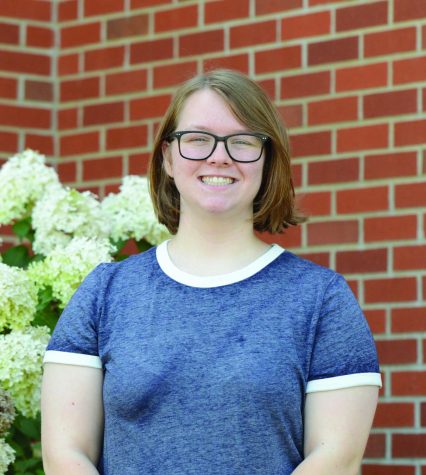Former department converted to school; School of English and Interdisciplinary Studies begins year one
Michael Nagy, a profesor from the School of English, sits with English Major Kathryn Bradeen at a Craft N Chat event for the English Club.
October 4, 2022
Over the summer, South Dakota State University officially opened the School of English and Interdisciplinary Studies, formerly known as the department of English and interdisciplinary studies.
This is the last department in the College of Arts, Humanities and Social Sciences to be converted into a school, following the School of Design in 2015, the School of Performing Arts in 2017, the School of Communication and Journalism in 2018, the Ness School of Management and Economics and the School of American and Global Studies in 2019 and the School of Psychology, Sociology and Rural Sciences in 2021.
“What we ended up doing was sitting down with other people across the college, including the dean’s office, and tried to decide what programs out there, whether they be academic programs, minors, majors, etc., what programs out there are sort of floating around,” Jason McEntee, director of SEIDS, said.
The school now offers majors in English, with specializations in English education and writing, and in interdisciplinary studies. Interdisciplinary studies allows students to combine classes from two or three different majors into one program.
McEntee said officially placing the interdisciplinary studies program in a school increased interest in it as a major.
“In the case of interdisciplinary studies, it took a legitimate degree, a totally legitimate degree, but for whatever reason the optics of [the school] made it … seem more legitimate in the eyes of our students,” he said.
The new school has also taken some free-floating minors under its umbrella, as well.
“We’re very excited not only about bringing together English and interdisciplinary studies majors and minors, but also because we’ve got some very exciting minors housed in our school now – the women, gender and sexuality studies minor and the film studies minor,” Sharon Smith, an associate English professor, said.
Because many of these programs don’t have affiliated faculty, as well, moving them into SEIDS was less complicated than it would have been for other programs, according to McEntee.
Another benefit of converting the department to the school was increasing student awareness of these programs. McEntee said the number of students enrolled in some programs has already doubled or more in a few cases.
“Film studies went from like eight or nine minors, and now we’re at 17,” McEntee said. “And women’s and gender studies went from three to I believe 18.”
Forming the school also resulted in re-establishing some student organizations like English Club. Myja Miller, president of the club and English major, said the club has received a lot of support and excitement so far.
“The response I’ve seen so far is nothing but sheer excitement and enthusiasm,” she said. “All the faculty that I’ve [spoken] with have been 100% supportive of me and the club’s endeavors. All of my friends and peers in the English program have expressed excitement for any and all activities that we’re hosting.”
Smith said the school is also planning a film series event, starting with “The Lighthouse” at 6:30 p.m. Oct. 20.
“This month we’ll be kicking off our film series From Page to Screen that focuses on film adaptations of literary texts by writers like Edgar Allan Poe, Emily Dickinson and James Baldwin,” she said.
Each film will be followed by a brief panel-led discussion.
SEIDS will host a kickoff event from 4-6 p.m. Oct. 13 on Sylvan Green by the South Dakota Art Museum. Refreshments will be served and some faculty from the school will be performing poetry readings.

























